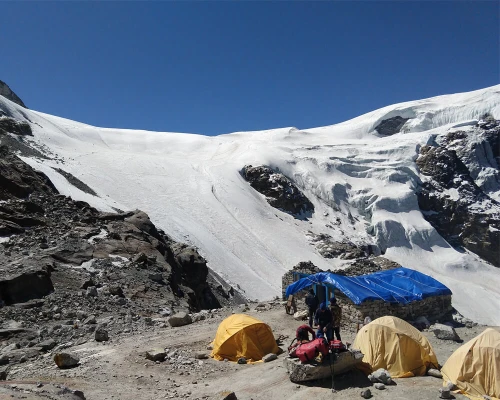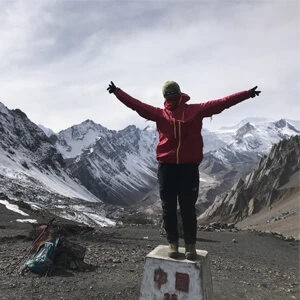Mera Peak Trekking with Climbing Overview
Our route to the Mera Peak Trekking with Climbing, Nepal's highest trekking peak, takes us through the traditional Everest gateway of Lukla. The hike to the area takes us through an undulating landscape of cascading rivers, dense pine, and rhododendron forests, and ever-higher valleys and trails leading us to our ultimate goal of Climbing Mera Peak and our high camp at 5800 meters. While the climb is technically straightforward, the mountain's height is such that oxygen levels are half those at sea level, so either previous climbing experience or a period of acclimatization via a trek is recommended before attempting the summit.
The hike itself is more a test of resolve than technique, with the final push to the summit aided by fixed ropes laid by the guide to aid in the ascent. Once on top of Mera, the views of the surrounding area are among the finest one could hope for an eagle's eye view of the entire Khumbu basin and the surrounding Himalayan giants, from mighty Everest to Lhotse, Makalu, and Cho Oyu, with even distant Kanchenjunga visible on a clear day. After the summit bid, we descend back through the base camp and make our way back toward Lukla, congratulating ourselves on our never-to-be-forgotten experience.
If you want to get that first taste of climbing a Himalayan peak or simply want to take that extra step over a typical trek through Nepal, climbing Mera Peak may will be the perfect solution. Why not get in touch with us and go over the options with us? The two windows of opportunity for making the climb are March through May and September through November.
Moreover, you may also take a look at our the Everest Base Camp Trek with Island Peak climbing, Everest Base Camp Trek with Lobuche Peak Climbing, or the Everest Three High Passes Trek with Island Peak Climbing.
How Difficult is Mera Peak Trekking & Climbing?
The Mera Peak Trekking and Climbing presents a moderate to challenging blend of accessibility with demanding terrain. Spanning approximately 18 days Mera Peak Trekking with Climbing initially passes through the verdant hills with minimal icy ridges and glaciers. It is a relatively approachable path suitable for both beginners and experienced climbers. However, maintaining a good fitness level is crucial due to the trek's duration and altitude gains.
The ascent's difficulty escalates with the altitude, as climbing Mera Peak is one of the highest trekking peaks of Nepal at 6461 meters. The elevation shows the physical demands and acclimatization requirements. While technical climbing skills are not extensively needed, the journey's length and altitude necessitate endurance and careful preparation to ensure a safe and successful summit bid.
What is the Best Time for Mera Peak Climbing?
After conducting over 100 trekking trips to the Mera region we have noted that the best time to do Mera Peak climbing are Spring (March, April, and May) and Autumn (September, October, and November). Despite winter and summer having their own charm there is something different about these seasons.
Spring Season: March, April, and May
The Spring season from March to May enhances the beauty of the region. The mild and stable weather conditions with daytime temperatures around 5 to 20°C make the trail more comfortable and during the night time, you may expect more or less 0 to -25°C. The clear skies provide breathtaking views of iconic mountains like Everest, Makalu, Lhotse, and Kanchenjunga.
Additionally, the blooming rhododendrons and lush greenery along the Makalu Barun National Park add to the picturesque landscape. Longer daylight hours ensure safer climbing conditions, and there's the added cultural experience of participating in local festivals like Holi and Nepali New Year.
Autumn Season: September, October, and November
Autumn is one of the best stable weather with clear skies and minimal rain or snow for great visibility and comfortable trekking conditions. Daytime temperatures range from 1 to 20°C, ideal for trekking and climbing, while nights can be chilly, such as 0 to -25°C.
The landscapes are stunning with colorful autumn foliage and green forests that create a beautiful backdrop for the trek. Moreover, the autumn also coincides with Nepali festivals like Dashain and Tihar, adding cultural experiences to the journey.
Winter Season: December, January, and February
Winter Season lasts from December to February and invites fewer climbers due to colder temperatures and more challenging trail conditions with snow and ice. While the charm of winter scenery may attract some, climbers must be cautious of the harsh weather and potential hazards on the mountain. Nepal Trekking Experts do not recommend winter climbing for the beautiful experience.
Summer Season : June, July, and August
The Summer Season for climbing the Mera Peak is from June to August, and is not recommended for climbing Mera Peak due to the monsoon season. Heavy rainfall and cloudy conditions can obscure mountain views, make trails slippery, and increase the risk of landslides and avalanches, which makes it unsafe for climbing. It is not recommended to climb in the Summer.
Mera Peak Trekking and Climbing Permit Cost:
When climbing the Mera Peak there is a requirement of two permits. One is the Makalu Barun National Park permit and the other is the Nepal Mountaineering association permit.
- Makalu Barun National Park Permit: NPR 3000 (applicable for various activities including trekking and climbing within the park)
Nepal Mountaineering Association (NMA) Permit: The permit fees can vary depending on the specific peak. For Mera Peak, the permit fee is as follows:
- Spring (March to May): USD 250 per person
- Autumn (September to November): USD 125 per person
- Winter (December to February): USD 70 per person
- Summer (June to August): USD 70 per person
How can I book the Mera Peak Climbing with Nepal Trekking Experts?
To book your trek with us, you have to send a 10% deposit of the total cost. Please also forward a copy of your passport, a passport-sized photo, and full flight details if and when available. For your convenience, you may forward the deposit online through our website. It is completely safe, and as soon as you make it, you will get an automatic receipt in your inbox. The rest of the payment can be paid upon arrival.










 based on 2 reviews
based on 2 reviews





